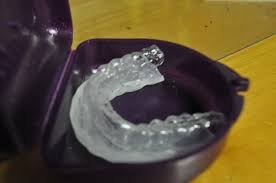Everything athletic seems to be gearing up, whether it’s school sports teams or travel or recreational leagues: football, field hockey, boys and girls soccer, tennis, fall softball and baseball, cross country and we’re sure there are more.
Some of these sports have a lot of protective equipment, like football. Some, like tennis have absolutely no required protection. Sports protective equipment includes shin guards, helmets, and shoulder pads.
Reasonable sports protective equipment should also include mouthguards. Some sports do have mandatory “no mouthguard, no play” policies. These include football, ice hockey and field hockey
A 1995 study on mouthguards reveals the following statistics about mouth injuries:
In football, where mouthguards are required, .07% of the injuries are orofacial.
But in basketball, where mouthguards are typically not required and absolutely not required, 34% of the injuries are orofacial.
According to the Australian Dental Association, studies of mouthguard users and nonusers have consistently shown that “mouthguards offer significant protection against sports-related injuries to the teeth and soft tissues. Mouthguards provide a resilient, protective surface to distribute and dissipate forces on impact, thereby minimizing the severity of traumatic injury to the hard or soft tissues.”
The American Dental Association recommends fitted mouth guards for all sports participants who have any chance of orofacial contact.
There are different types of fitted and non-fitted mouthguards:
- Stock mouthguards
- “Boil and bite” mouthguards
- Custom fit mouthguards
Stock mouthguards are extremely cheap, and are often given away for free. They are not personalized or fitted at all. They provide little or no protection. They can be uncomfortable and they certainly are unlikely to remain in place during sports practice or games.
Boil and Bite mouth guards are so-called because they require you to boil them and bite down to help them fit. These boil and bites are available at sporting goods stores; they are inexpensive (under $30).
Boil and bite guards are most likely better than nothing at all. But boil and bite guards are not always the best option. They can move around if the first impression is inaccurate. Poorly fitting mouthguards may inadequately protect the teeth and gums. Boil and bites also are shorter, and don’t cover the back teeth. In addition, athletes sometimes cut or fold the guards to try to make them feel better or fit better. Cutting the guards makes them less protective.
Custom mouthguards are fitted by your dentist and then formed to fit your mouth after the dentist has taken a stone impression of your mouth. These custom mouthguards are also made of a type of plastic composite, but are thicker and more durable than boil and bites. They also take into account how the user bites down and the idiosyncrasies of each mouth, including missing teeth, erupting teeth, orthodontia and implants. In addition, the dentist can provide additional protection if the patient has had a history of a previous dental injury or even concussion.
All athletes should recheck their bite guards if there has been a change in bite, due to oral surgery, tooth extraction, or significantly for student athletes, installation or removal of orthodontia.
All athletes should inform their dentists about their athletic involvement and decide together on the best mouthguard choice.
